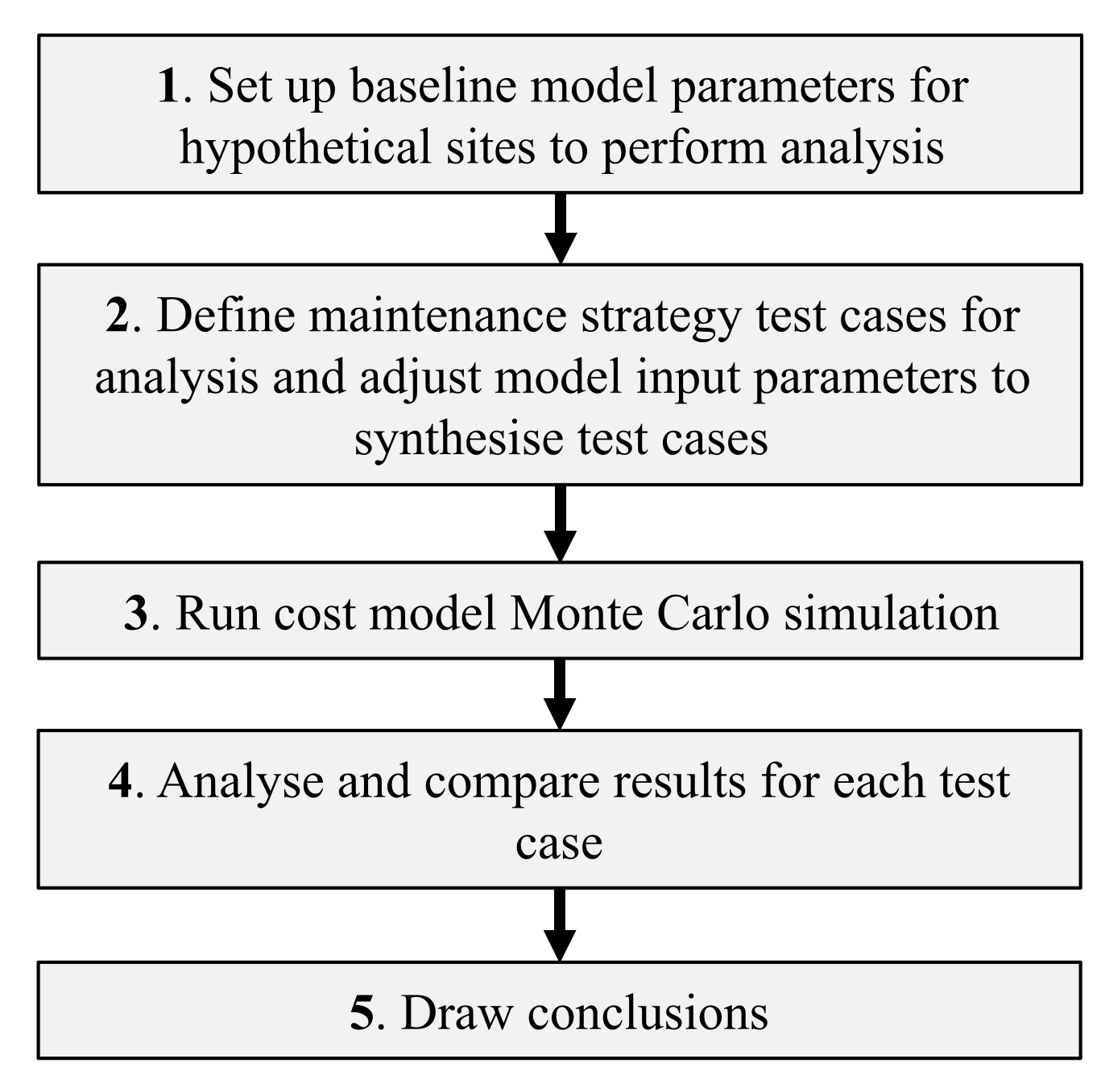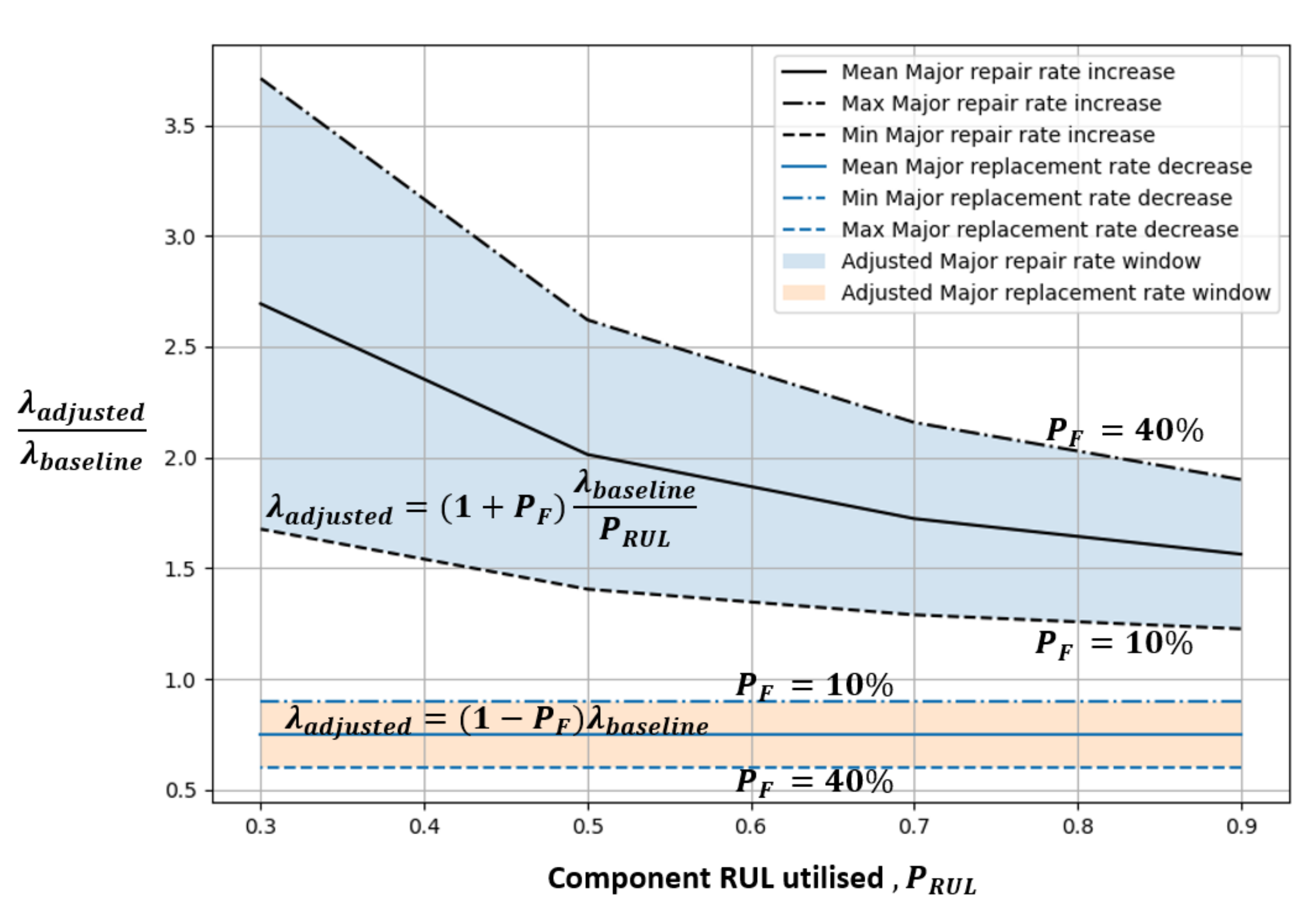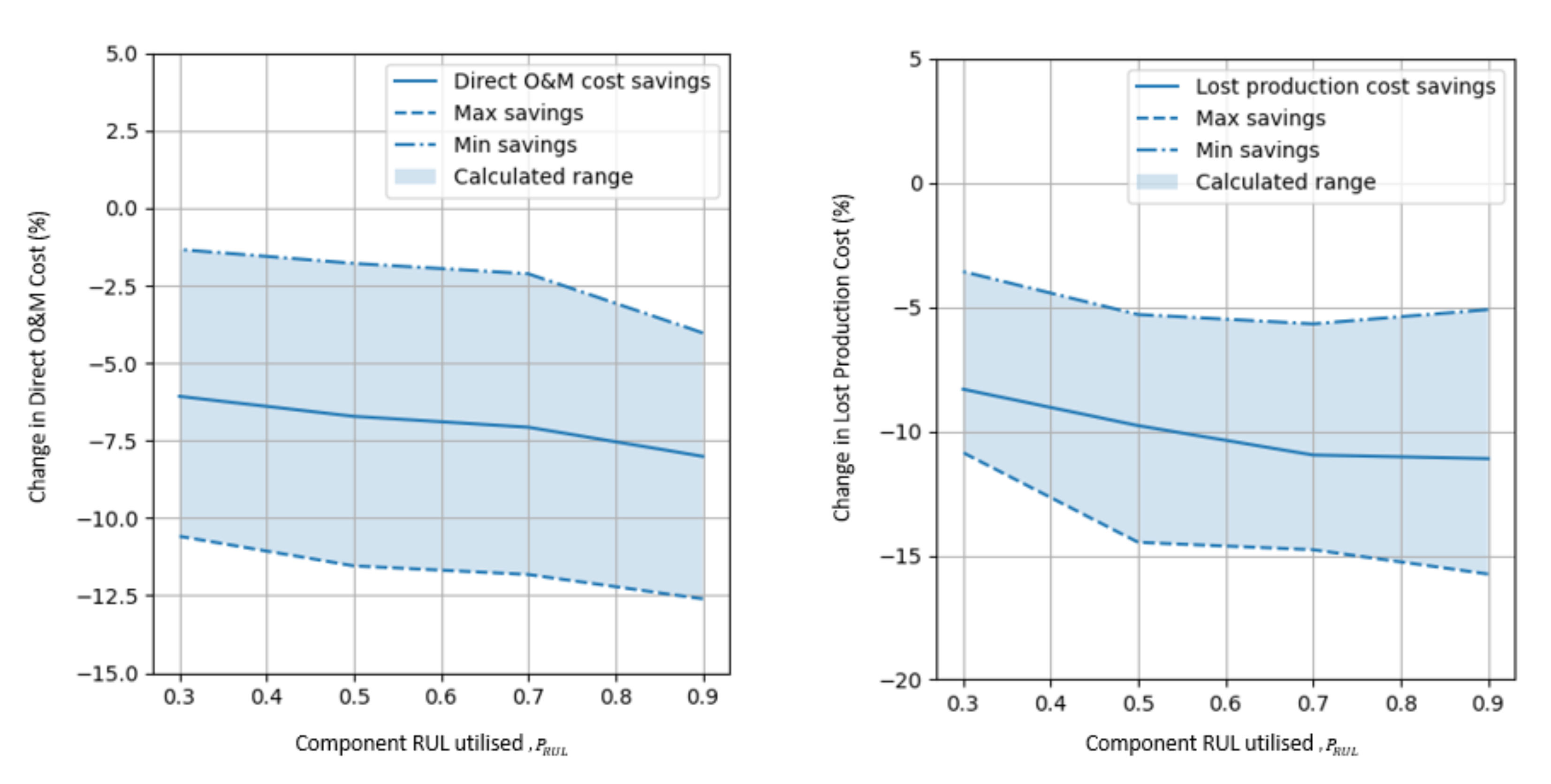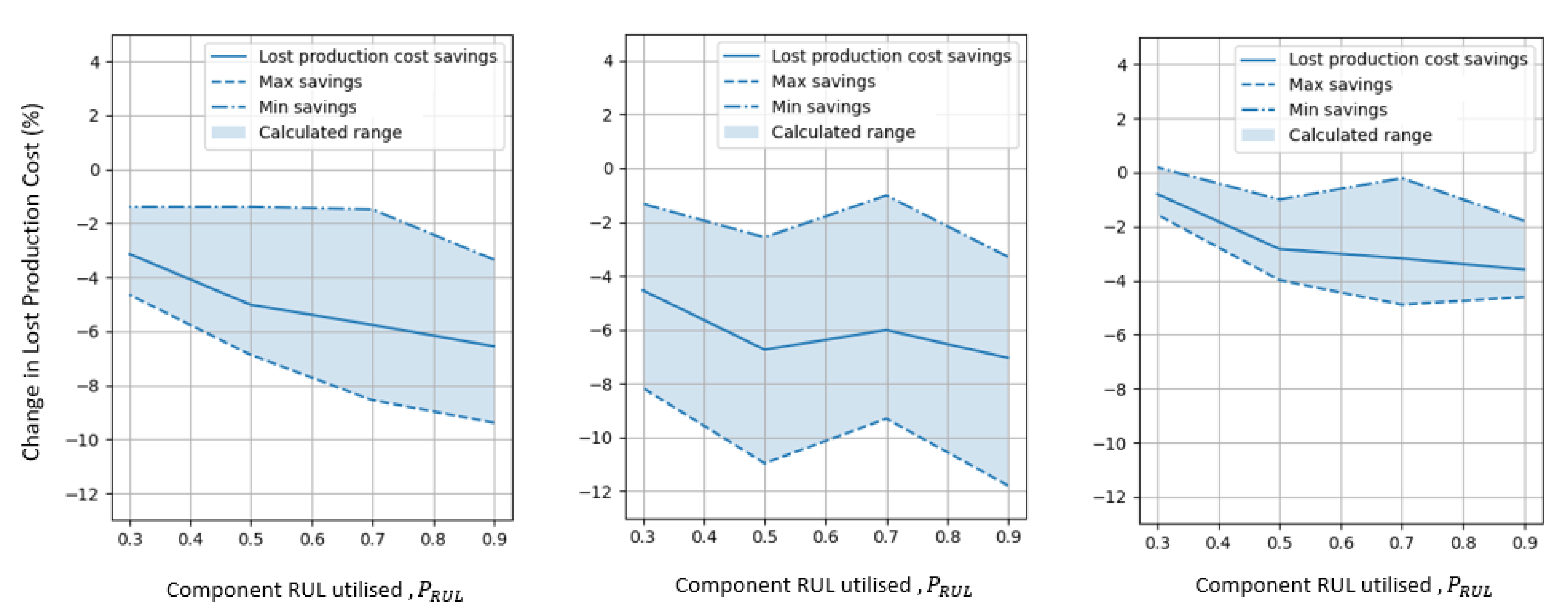Cost Benefit of Implementing Advanced Monitoring and Predictive Maintenance Strategies for Offshore Wind Farms
Abstract
:1. Introduction
2. Literature Review
3. Methodology and Model Overview
3.1. Methodology
3.2. O&M Cost Model Description
3.3. Theoretical Site Characteristics
3.4. Types of Maintenance Strategies
3.5. Analysis Cases
3.5.1. Baseline Failure Rates
3.5.2. Adjusted Failure Rates
4. Results
4.1. Baseline O&M Costs
4.2. Effects of Predictive and Condition-Based Maintenance Strategies
4.3. Analysis of Wind Farm Size and Location
5. Discussion
6. Conclusions
- With input parameters described throughout the methodology, results showed a potential cost reduction of up to 8% in direct O&M costs (transport, staff and repair costs) and up to 11% reduction in lost production by utilising advanced monitoring strategies, assuming 25% of major failures of the generator and gearbox can be diagnosed through advanced monitoring and repaired before major replacement is required. This increases to 12.5% and 15.75% respectively, with of 40%.
- Results showed that the major driving factor of realising these savings is through early intervention to avoid failure and major component replacement, and hence avert the need to use a HLV and instead use a CTV for a simpler repair.
- Findings indicate that opting for predictive or condition-based maintenance strategies can generate substantial savings over the lifetime of a wind farm when compared to a more reactive approach. Furthermore, using a more condition-based approach and pushing components closer to the end of their RUL can further reduce costs due to increased overall availability and reduced lost revenue.
- If weighing up the risk of component failure and replacing a component too early, results suggest that it is more cost effective to intervene earlier if HLVs can be avoided, even if that means more major repairs over the lifetime of the site.
6.1. Result Limitations
6.2. Future Work
Author Contributions
Funding
Institutional Review Board Statement
Informed Consent Statement
Data Availability Statement
Acknowledgments
Conflicts of Interest
Abbreviations
| CMS | Condition Monitoring System |
| CRV | Crew Transfer Vessel |
| DD | Direct Drive |
| DFIG | Doubly Fed Induction Generator |
| FRC | Fully Rated Converter |
| HLV | Heavy Lift Vessel |
| LCOE | Levelised Cost of Energy |
| O&M | Operations and Maintenance |
| OPEX | Operational Expenditure |
| PMG | Permanent Magnet Generator |
| RUL | Remaining Useful Life |
| WT | Wind Turbine |
References
- Santos, F.; Teixeira, A.P.; Soares, C.G. Modelling and simulation of the operation and maintenance of offshore wind turbines. J. Risk Reliab. 2015, 229, 385–393. [Google Scholar] [CrossRef]
- May, A.; McMillan, D.; Thöns, S. Economic analysis of condition monitoring systems for offshore wind turbine sub-systems. IET Renew. Power Gener. 2015, 9, 900–907. [Google Scholar] [CrossRef] [Green Version]
- Crabtree, C.J.; Zappala, D.; Hogg, S.I. Wind energy: UK experiences and offshore operational challenges. Proc. Inst. Mech. Eng. Part A J. Power Energy 2015, 229, 727–746. [Google Scholar] [CrossRef] [Green Version]
- Valpy, B.; Philip, E. Future Renewable Energy Costs: Offshore Wind, How Technology Innovation Is Anticipated to Reduce the Cost of Energy from European Offshore Wind Farms. 2014. Available online: https://eit.europa.eu/library/future-renewable-energy-costs-offshore-wind (accessed on 11 May 2019).
- Tchakoua, P.; Wamkeue, R.; Ouhrouche, M.; Slaoui-Hasnaoui, F.; Tameghe, T.A.; Ekemb, G. Wind turbine condition monitoring: State-of-the-art review, new trends, and future challenges. Energies 2014, 7, 2595–2630. [Google Scholar] [CrossRef] [Green Version]
- Carroll, J.; McDonald, A.; McMillan, D. Reliability Comparison of Wind Turbines With DFIG and PMG Drive Trains. IEEE Trans. Energy Convers. 2015, 30, 663–670. [Google Scholar] [CrossRef] [Green Version]
- McMillan, D.; Ault, G.W. Quantification of Condition Monitoring Benefit for Offshore Wind Turbines. Wind Eng. 2016, 31, 267–285. [Google Scholar] [CrossRef]
- Tsui, K.L.; Chen, N.; Zhou, Q.; Hai, Y.; Wang, W. Prognostics and health management: A review on data driven approaches. Math. Probl. Eng. 2015, 2015. [Google Scholar] [CrossRef] [Green Version]
- Liu, R.; Yang, B.; Zio, E.; Chen, X. Artificial intelligence for fault diagnosis of rotating machinery: A review. Mech. Syst. Signal Process. 2018, 108, 33–47. [Google Scholar] [CrossRef]
- Tautz-Weinert, J.; Watson, S. Using SCADA data for wind turbine condition monitoring—A review. IET Renew. Power Gener. 2017, 11, 382–394. [Google Scholar] [CrossRef] [Green Version]
- Stetco, A.; Dinmohammadi, F.; Zhao, X.; Robu, V.; Flynn, D.; Barnes, M.; Keane, J.; Nenadic, G. Machine learning methods for wind turbine condition monitoring: A review. Renew. Energy 2019, 133, 620–635. [Google Scholar] [CrossRef]
- Turnbull, A.; Carroll, J.; McDonald, A. Combining SCADA and vibration data into a single anomaly detection model to predict wind turbine component failure. Wind Energy 2021, 24, 197–211. [Google Scholar] [CrossRef]
- Turnbull, A.; Carroll, J.; McDonald, A.; Koukoura, S. Prediction of wind turbine generator failure using two-stage cluster-classification methodology. Wind Energy 2019, 22, 1593–1602. [Google Scholar] [CrossRef]
- Hahn, B.; Durstewitz, M.; Rohrig, K. Reliability of wind turbines—Experiences of 15 years with 1500 WTs. Wind Energy 2007, 328–330. [Google Scholar] [CrossRef]
- Spinato, F.; Tavner, P.J.; van Bussel, G.J.W.; Koutoulakos, E. Reliability of wind turbine subassemblies. IET Renew. Power Gener. 2009, 3, 387–401. [Google Scholar] [CrossRef] [Green Version]
- Wilkinson, M.; Hendriks, B.; Spinato, F.; Harman, K.; Gomez, E.; Bulacio, H.; Roca, J.; Tavner, P.J.; Feng, Y.; Long, H. Methodology and results of the reliawind reliability field study. In Proceedings of the European Wind Energy Conference, Warsaw, Poland, 20–23 April 2010. [Google Scholar]
- Artigao, E.; Martín-Martínez, S.; Honrubia-Escribano, A.; Gómez-Lázaro, E. Wind turbine reliability: A comprehensive review towards effective condition monitoring development. Appl. Energy 2018, 228, 1569–1583. [Google Scholar] [CrossRef]
- Dao, C.; Kazemtabrizi, B.; Crabtree, C. Wind turbine reliability data review and impacts on levelised cost of energy. Wind Energy 2019, 22, 1848–1871. [Google Scholar] [CrossRef] [Green Version]
- Koukoura, S.; Scheu, M.N.; Kolios, A. Influence of extended potential-to-functional failure intervals through condition monitoring systems on offshore wind turbine availability. Reliab. Eng. Syst. Saf. 2021, 208, 107404. [Google Scholar] [CrossRef]
- Dinwoodie, I. Modelling the Operation and Maintenance of Offshore Wind Farms. Ph.D. Thesis, University of Strathclyde, Glasgow, UK, 2014. [Google Scholar]
- Carroll, J.; McDonald, A.; Dinwoodie, I.; McMillan, D.; Revie, M.; Lazakis, I. Availability, operation and maintenance costs of offshore wind turbines with different drive train configurations. Wind Energy 2017, 20, 361–378. [Google Scholar] [CrossRef] [Green Version]
- Carroll, J. Cost of Energy Modelling and Reduction Opportunities for Offshore Wind Turbines. Ph.D. Thesis, University of Strathclyde, Glasgow, UK, 2016. [Google Scholar]
- Carroll, J.; McDonald, A.; McMillan, D. Failure rate, repair time and unscheduled O and M cost analysis of offshore wind turbines. Wind Energy 2016, 19, 1107–1119. [Google Scholar] [CrossRef] [Green Version]







| Maintenance Strategy | Description |
|---|---|
| Preventative | Routine maintenance to minimise the risk of faults developing. |
| Reactive | Maintenance performed retrospectively after component failure. |
| Predictive | Prognosis is performed after fault is detected with replacement scheduled accordingly based on availability of resources and site conditions. |
| Condition based | Ongoing assessment performed once a fault has been detected and maintenance is performed when condition has worsened to a set threshold. |
| System | Intervention | Intervention | Vessel |
|---|---|---|---|
| Category | Example | Type | |
| Generator | Major Replacement | Full generator replacement | HLV |
| Generator | Major Repair | Slip-ring replacement | CTV |
| Generator | Minor Repair | Re-alignment | CTV |
| Gearbox | Major Replacement | Full gearbox replacement | HLV |
| Gearbox | Major Repair | Highspeed assembly replacement | CTV |
| Gearbox | Minor Repair | Oil system flush | CTV |
| Failure Category | Gearbox | Generator | Converter | Rest of Turbine |
|---|---|---|---|---|
| Major Replacement | 0.154 | 0.095 | 0.005 | 0.11 |
| Major Repair | 0.038 | 0.321 | 0.081 | 0.622 |
| Minor Repair | 0.395 | 0.485 | 0.076 | 5.222 |
| Scenario | No. | Distance | Percentage | Percentage |
|---|---|---|---|---|
| No. | Turbines | Offshore | Failures | RUL |
| 1 | 100 | 25 km | 10–40% | 30–90% |
| 2 | 50 | 25 km | 10–40% | 30–90% |
| 3 | 50 | 50 km | 10–40% | 30–90% |
| 4 | 50 | 100 km | 10–40% | 30–90% |
| Costs Category | £/MWhr |
|---|---|
| Lost Revenue | 13.14 |
| Transport Costs | 13.93 |
| Staff and Repair Costs | 3.80 |
| Total O&M Costs | 30.87 ± 0.15 |
| Total Direct O&M Costs | 17.73 ± 0.098 |
Publisher’s Note: MDPI stays neutral with regard to jurisdictional claims in published maps and institutional affiliations. |
© 2021 by the authors. Licensee MDPI, Basel, Switzerland. This article is an open access article distributed under the terms and conditions of the Creative Commons Attribution (CC BY) license (https://creativecommons.org/licenses/by/4.0/).
Share and Cite
Turnbull, A.; Carroll, J. Cost Benefit of Implementing Advanced Monitoring and Predictive Maintenance Strategies for Offshore Wind Farms. Energies 2021, 14, 4922. https://doi.org/10.3390/en14164922
Turnbull A, Carroll J. Cost Benefit of Implementing Advanced Monitoring and Predictive Maintenance Strategies for Offshore Wind Farms. Energies. 2021; 14(16):4922. https://doi.org/10.3390/en14164922
Chicago/Turabian StyleTurnbull, Alan, and James Carroll. 2021. "Cost Benefit of Implementing Advanced Monitoring and Predictive Maintenance Strategies for Offshore Wind Farms" Energies 14, no. 16: 4922. https://doi.org/10.3390/en14164922
APA StyleTurnbull, A., & Carroll, J. (2021). Cost Benefit of Implementing Advanced Monitoring and Predictive Maintenance Strategies for Offshore Wind Farms. Energies, 14(16), 4922. https://doi.org/10.3390/en14164922






